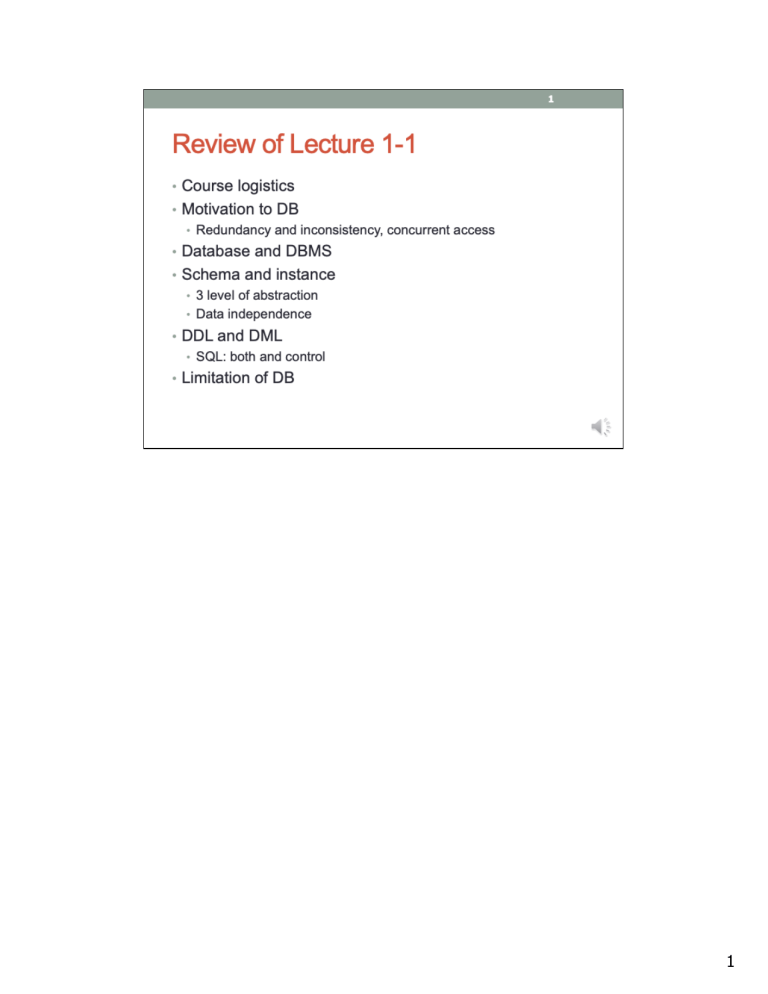
1
2
Structure of DB defined by its data model, the most popular one is
relational model
3
4
5
Most widely used model in logical design
Its query language is powerful and well supported in SQL
It is simple to understand and often match how we think about data
Recent competitor: OO and OR
A collection/list …
The model underlies SQL the most popular/important database language
today
A synthesis:
Interesting question: it is popular, so we study it. But why is it popular in
the first place.
Be aware: that is DBMS dependent!!
6
A relation is similar to a table with a twists. Each row represents one realworld E. Each col represent the attribute of the entity. Possible values for
an attribute is called a domain.
What is a set? No order and no duplicates! So a relation is a table with
NO duplicate rows.
How can you make sure no duplicate row? It means that each row must
have something unique. This is called a primary key (sometimes just
called a key) and each table must have a primary key.
7
This relation is called account.
The column headers are the attributes. The domain for each attribute?
Integer, string, real, enumeration with two possible values.
We switch the whole columns (whether the header/schema is included
makes no difference).
1. If we just switch the instance columns (101 with 1000.00) but headers
remain the same, it is obvious that the result table is not the same table
as the original. Schema is the same, but content is different.
2. If we switch the whole columns (including the headers), the new table
is (Balance, Number, Owner, Number, Type). Is the new table the same
as the original? Not automatically.
3. But if we switch row 101 with row 105, the result table is considered
identical to the original.
Going back to the basics, a row is a tuple. Mathematically, (1,a) != (a,1).
Order of the members (columns in tabular form) is important.
However, table/relation is a set of rows. Mathematically, {(1,a), (1,b)} =
{(1,b), (1,a)}. Order of the members (rows in tabular form) is irrelevant.
8
The union of all attributes is the schema of the relation, which defines the
structure of the relation.
9
The content of the relation is called the instance.
Instance: change frequently, each add, delete, update changes the
instance.
Schema: not so much
10
Is (Michael, Jordan) = (Jordan, Michael)?
DBMS uses schema to interpret the instance (each is stored in a different
place). So using (FN, LN) to interpret (Michael, Jordan) gives you
different information from using the same schema to interpret (Jordan,
Michael).
I should clarify the order of rows/columns: when you shuffle the rows in
the instance, the same schema gives you the exact same information as
before the shuffle. But if you shuffle the columns in the instance, the
schema will interpret it differently. Hence the order of the rows in the
instance is irrelevant, but the order of the columns matters a lot.
11
Analogy:
Prove that A+A=A*A
When A = 2, it is correct. So the equation is correct? Obviously NOT. We
can try A = 1 and it does not hold
A = 2 is like an instance and A =1 is another instance, the equitation is
correct for one instance does not mean it is correct.
However, if the equation is wrong for one instance, it MUST be wrong.
So we can use instance to prove something is wrong but never to prove
something is correct.
12
13
Each row inside the table is also called tuple or record. Order of the tuples/rows is not important
By definition, relation is a set of tuples, no order among row. In terms of semantics, relation represents real world facts at a logical or
abstract level. Many logical orders can specified on a relation, By Last Name or SID etc. But this is not part of the relation definition:
there is no preference for one logical tuple over another. It is the user who might have preference over certain displaying order.
However, order of the attributes (columns) does play an important part. Remember that DBMS uses schema to interpret the data. So
the order of attributes in schema and in the table must match!
Change the order of rows, still the same table; but change the order of columns => different table!
Implementation and performance issue …
As you can see, logical schema and physical are separated (you can have many logical orders, index, over one physical database; of
courses, need different physical index file, but user transparent; accessing the same file from user point of veiw). Not like in legacy
system (hierarchical or network, logical order and physical order are the same)
++++++++++++++++++++++++++++++
A tuple is an ordered set of values
Each value is derived from an appropriate domain.
Each row in the CUSTOMER table may be referred to as a tuple in the table and would consist of four values.
<632895, "John Smith", "101 Main St. Atlanta, GA 30332", "(404) 894-2000">
is a tuple belonging to the CUSTOMER relation.
A relation may be regarded as a set of tuples (rows).
Columns in a table are also called attributes of the relation.
Each Tuple represetns one entity in ER or real world
How about order of attributes? Some do, some don’t (n-tuple, is ordered …) Physically they are stored in order as fields within a record.
We follow the former here, unless say otherwise
14
Ordering of tuples in a relation r(R): The tuples are not considered to be ordered, even though they appear to be in
the tabular form.
Ordering of attributes in a relation schema R (and of values within each tuple): We will consider the attributes in
R(A 1, A 2, ..., A n) and the values in t=<v1, v2, ..., vn> to be ordered .
(However, a more general alternative definition of relation does not require this ordering).
Values in a tuple: All values are considered atomic (indivisible). A special null value is used to represent values that
are unknown or inapplicable to certain tuples.
14
Be aware degree of relation vs. degree of relationship!
15
Use the terms interchangeably.
Note that every time we say table,
we mean table as set of rows.
16
Formally relation is a set of n-tuples, a1, a2 are the attributes, and D1,
D2 are the domains of the attributes. each value of the tuple come from a
domain.
Two very important facts:
Regardless of the domain of the attribute (int, char, string etc.), the value
of an attribute could always be null.
A domain has a logical definition: e.g.,
“USA_phone_numbers” are the set of 10 digit phone numbers valid in the
U.S.
A domain may have a data-type or a format defined for it. The
USA_phone_numbers may have a format: (ddd)-ddd-dddd where each d
is a decimal digit. E.g., Dates have various formats such as monthname,
date, year or yyyy-mm-dd, or dd mm,yyyy etc.
An attribute designates the role played by the domain. E.g., the domain
Date may be used to define attributes “Invoice-date” and “Payment-date”.
17
A relation database is a collection of data broken into relations.
Not a good idea to keep everything in one single table:
1. Redundancy: For example, two customer share the same account …
store the account info twice
2. Null: customer has no check will have null for check information
18
Example of a relation database, with 3 populated tables.
Related information stored in a structure format:
Structure here are tables.
How the information is connected to each together?
19
Every instance of a DB must satisfy some rules called all ICs. In
other words, each time you add, delete or update the DB, all IC
must be checked by the DBMS to see whether the action is legal.
Constraints are specified the developer during database development,
but enforced automatically by DBMS
20
21
22
Set: unique row!
23
Why PK? Having two more rows that are identical does not make sense!
So every row must be unique. So there must exist a minimal set of
attributes making each row unique.
24
If you are looking for account 102 in the Account table because of
possible money laundering, I can uniquely identify one and only one row
that you are looking for. So Number is a PK in Account.
However, if you say you want to put $100 to account belong to J Smith in
the Account able, I cannot tell which specific account you are depositing.
So Owner can NOT be a PK in Account.
Can Check-number alone be sufficient as the PK in the Check table?
25
26
27
Let’s take a look at this example. Primary key and domain constraints are
all satisfied but what is wrong? We deposit something to an account that
does not exist! How can we prevent it?
28
Recall: DB stores related data, how to data in different tables? How do
they relate to each other? FK!
29
Unique (what if not unique?, That is candidate key) or null (customer just
want to cash a check?)
PK is mandatory for every table in DB but FK is optional. However, if you
do have FK, it must follow the rules.
A constraint involving two relations (the previous constraints involve a
single relation).
Used to specify a relationship among tuples in two relations: the
referencing relation and the referenced relation.
Tuples in the referencing relation R1 have attributes FK (called foreign
key attributes) that reference the primary key attributes PK of the
referenced relation R2. A tuple t1 in R1 is said to reference a tuple t2 in
R2 if t1[FK] = t2[PK].
A referential integrity constraint can be displayed in a relational database
schema as a directed arc from R1.FK to R2.
A way to represent relationship in relational model
30
Statement of the constraint
The value in the foreign key column (or columns) FK of the the referencing relation R1 can be either:
(1) a value of an existing primary key value of the corresponding primary key PK in the referenced
relation R2,, or..
(2) a null.
In case (2), the FK in R1 should not be a part of its own primary key.
30
If we establish Deposit.Account is a FK references Aaccount.Number in
our design, then DBMS will check whether account exist in Account table
when deposit to an account … …
31
Deposit.Amount references Account.Balance.
Transactions #3 will be rejected because 1000.00 is NOT unique in
Account.Balance. The system will be confused which 1000.00 is being
referenced.
Transaction #1, 2, and 6 will be rejected as well because the
corresponding values do not exist in Account.Balance.
#5 already been rejected
32
The impact of add, delete and update when having FK: you cannot perform these casucally. DBMS will check
whether they violate FK.
Integrity constraints should not be violated by the update operations.
Updates may propagate to cause other updates automatically. This may be necessary to maintain integrity
constraints.
In case of integrity violation, several actions can be taken:
Cancel the operation that causes the violation (REJECT option)
Perform the operation but inform the user of the violation
Trigger additional updates so the violation is corrected (CASCADE option, SET NULL option)
Execute a user-specified error-correction routine
33
34
35
Designer are responsible for IC
36
All three ICs introduced here can be achieved by a good design.
If not by design, we have to program it.
37
38
Exercise: identify the PK, FK, referencing table and referenced table in
the following example.
39
You can also specify FK as: Taught-By.Teacher references
Teacher.Number.
40
If you want to know the answers, please post your answers on the
discussion and we will comment on them.
41
42
43
44

